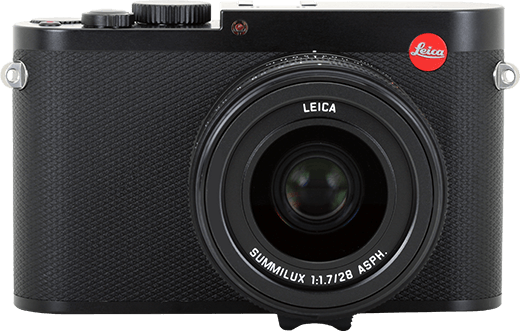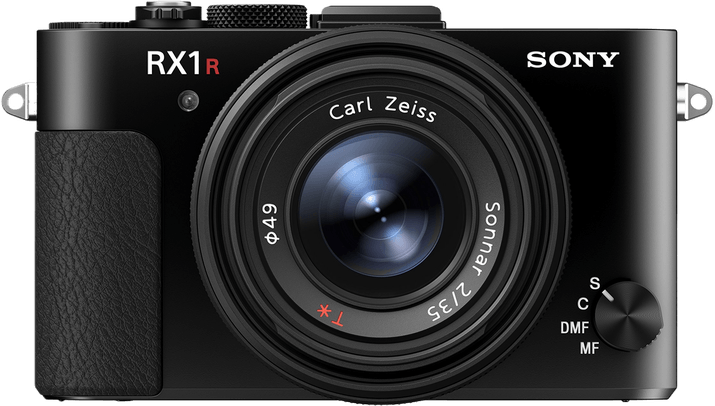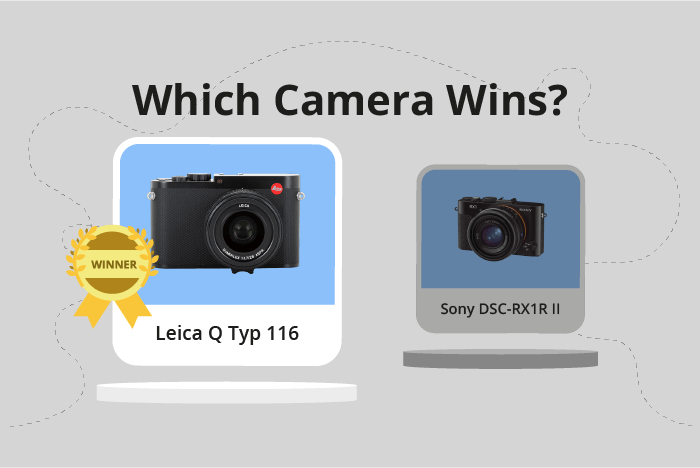Leica Q Typ 116 vs Sony Cyber-shot DSC-RX1R II Comparison
Leica Q Typ 116

Sony Cyber-shot DSC-RX1R II

The Leica Q Typ 116 edges out the Sony Cyber-shot DSC-RX1R II by a mere two points with scores of 64/100 and 62/100 respectively. Both cameras are compact models, released in 2015, with the Leica Q Typ 116 announced on June 10th and the Sony Cyber-shot DSC-RX1R II on October 14th. They share similarities in their launch prices, with the Leica Q Typ 116 priced at $4250 and the Sony Cyber-shot DSC-RX1R II at $3300.
The Leica Q Typ 116 boasts a larger size, measuring 130 x 80 x 93mm and weighing 640g (1.41lbs), which can contribute to better handling and stability when shooting. On the other hand, the Sony Cyber-shot DSC-RX1R II is more compact and lightweight, measuring 113 x 65 x 72mm and weighing 507g (1.12lbs), making it easier to carry around for daily use.
Taking all these factors into account, the Leica Q Typ 116 slightly outperforms the Sony Cyber-shot DSC-RX1R II due to its better handling and stability. However, the Sony Cyber-shot DSC-RX1R II is a solid choice for those seeking a more portable and lightweight camera.
Leica Q Typ 116 vs Sony Cyber-shot DSC-RX1R II Overview and Optics
The Sony Cyber-shot DSC-RX1R II outperforms the Leica Q Typ 116 in terms of optics, scoring 75/100 compared to Leica’s 72/100. Both cameras share some common specifications, such as using a CMOS sensor, having a full-frame sensor size, and employing a fixed lens mount, which means the lens cannot be changed. Additionally, neither camera features image stabilization.
The Sony Cyber-shot DSC-RX1R II stands out with its impressive 42.4-megapixel resolution, which is significantly higher than the Leica Q Typ 116’s 24.2 megapixels. This higher resolution allows the Sony camera to capture more detail and produce sharper images. Moreover, the Sony RX1R II has a superior DXOMARK score for its sensor (97) compared to the Leica Q Typ 116 (85), indicating better overall image quality.
On the other hand, the Leica Q Typ 116 excels in shooting speed, offering 10 frames per second compared to the Sony RX1R II’s 5 frames per second. This faster shooting speed makes the Leica camera more suitable for capturing fast-moving subjects and action photography.
In terms of optics, the Sony Cyber-shot DSC-RX1R II is a better choice due to its higher resolution and superior sensor performance. However, the Leica Q Typ 116 may be more suitable for action photography, thanks to its faster shooting speed. Ultimately, the choice between these two cameras will depend on the specific needs and preferences of the photographer.
Leica Q Typ 116 vs Sony Cyber-shot DSC-RX1R II Video Performance
The Leica Q Typ 116 wins the video capabilities comparison with a score of 70/100, while the Sony Cyber-shot DSC-RX1R II scores 56/100. Both cameras share some common specifications, such as a Full HD maximum video resolution of 1920 x 1080 and a maximum video frame rate of 60fps. However, there are differences that make the Leica Q Typ 116 stand out as the better option for video recording.
The Leica Q Typ 116 has a built-in time-lapse functionality, which is a significant advantage over the Sony Cyber-shot DSC-RX1R II, which lacks this feature. Time-lapse is a popular creative technique in videography, and having it built-in simplifies the process for users and eliminates the need for additional software or equipment.
On the other hand, the Sony Cyber-shot DSC-RX1R II does not have any notable advantages in video capabilities over the Leica Q Typ 116. Both cameras have the same maximum video resolution and frame rate, making them equal in terms of basic video performance. The absence of built-in time-lapse functionality in the Sony Cyber-shot DSC-RX1R II is a disadvantage compared to the Leica Q Typ 116.
Considering the video capabilities of both cameras, the Leica Q Typ 116 is the better choice due to its higher score and built-in time-lapse functionality. The Sony Cyber-shot DSC-RX1R II falls short in this aspect, offering no significant advantage in video performance. For users prioritizing video capabilities, the Leica Q Typ 116 is the clear winner in this comparison.
Leica Q Typ 116 vs Sony Cyber-shot DSC-RX1R II Features and Benefits
The Leica Q Typ 116 outperforms the Sony Cyber-shot DSC-RX1R II in features, with a score of 57/100 compared to 44/100. Both cameras share similarities such as a 3-inch screen size and the absence of GPS and Bluetooth. However, the differences in their features make one camera stand out over the other.
The Leica Q Typ 116 excels with its touchscreen capability, offering users a more intuitive and user-friendly experience. This feature is absent in the Sony Cyber-shot DSC-RX1R II, putting the Leica Q Typ 116 ahead in terms of user interaction.
On the other hand, the Sony Cyber-shot DSC-RX1R II has a higher screen resolution of 1,228,800 dots, compared to the Leica Q Typ 116’s 1,040,000 dots. Additionally, the Sony camera possesses a flip screen and Wi-Fi connectivity, making it more versatile and convenient for certain shooting situations and easier for sharing photos.
Despite these advantages, the Sony Cyber-shot DSC-RX1R II’s features score remains lower than that of the Leica Q Typ 116. The Leica Q Typ 116’s touchscreen functionality and overall higher features score make it the more desirable option for users seeking a camera with a robust set of features. The Sony Cyber-shot DSC-RX1R II, however, may still be a suitable choice for those prioritizing a higher screen resolution, flip screen, and Wi-Fi connectivity within their camera.
Leica Q Typ 116 vs Sony Cyber-shot DSC-RX1R II Storage and Battery
The Leica Q Typ 116 wins in the storage and battery category with a score of 16, while the Sony Cyber-shot DSC-RX1R II scores 13. Both cameras have one memory card slot and accept SD, SDHC, and SDXC cards. Neither camera supports USB charging.
The Leica Q Typ 116 outperforms the Sony Cyber-shot DSC-RX1R II in battery life, offering 300 shots per charge compared to the Sony’s 220 shots. The Leica uses a BP-DC12 battery, while the Sony uses an NP-BX1 battery.
The Sony Cyber-shot DSC-RX1R II has an advantage in memory card compatibility, as it also accepts Memory Stick Pro Duo cards. However, this does not make up for its shorter battery life.
Considering the longer battery life, the Leica Q Typ 116 proves to be a better choice in terms of storage and battery performance. The Sony Cyber-shot DSC-RX1R II offers additional memory card compatibility, but its shorter battery life limits its overall performance in this category.
Leica Q Typ 116 vs Sony Cyber-shot DSC-RX1R II – Our Verdict
Are you still undecided about which camera is right for you? Have a look at these popular comparisons that feature the Leica Q Typ 116 or the Sony Cyber-shot DSC-RX1R II:

